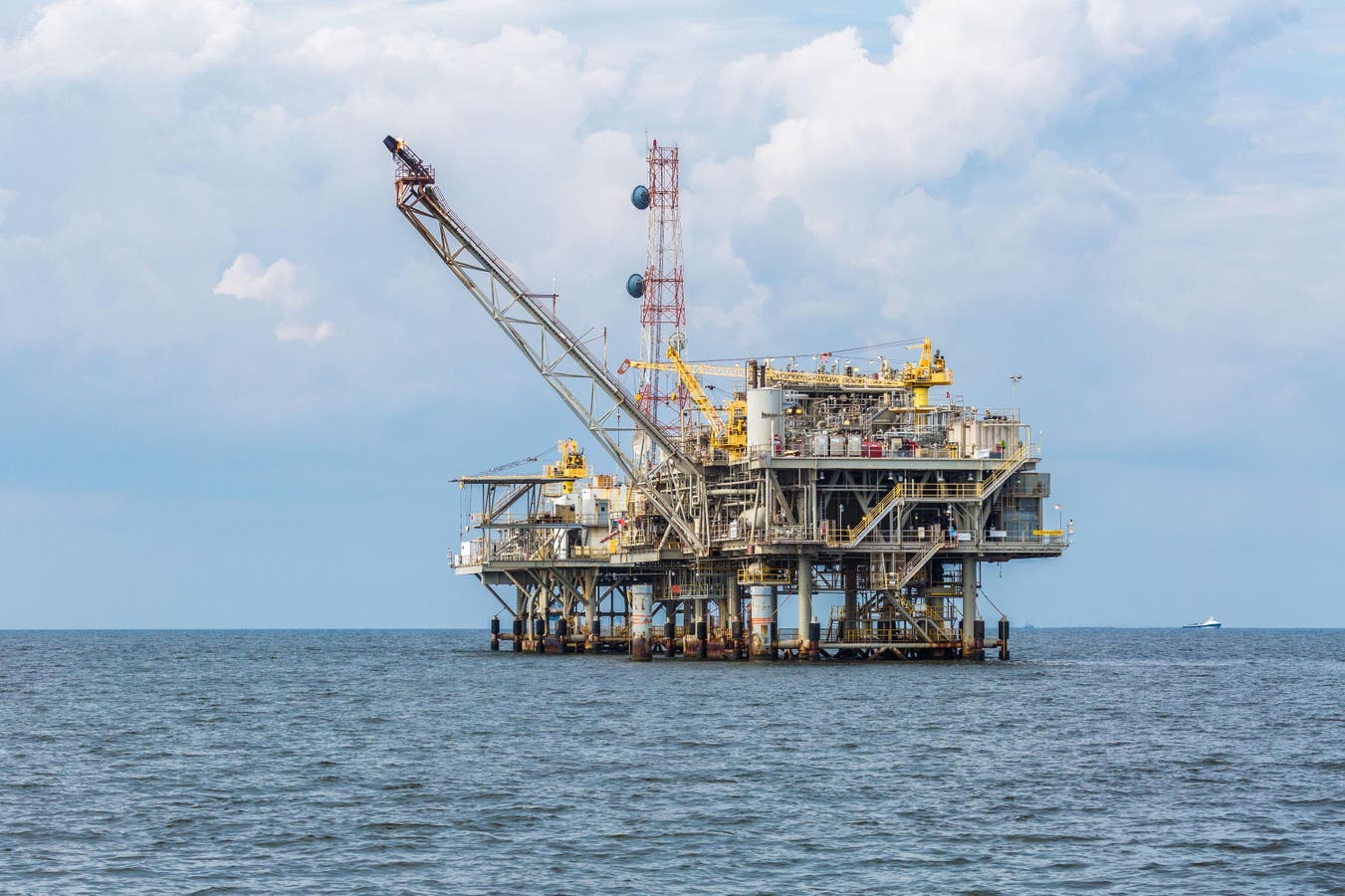Oil Slumps 20% In April To 4-Year Lows. Worse May Yet Follow
Exxon Mobil offshore platforms near the coastline off Dauphin Island, Alabama, U.S. (Photo: Ron … More Buskirk)
UCG/Universal Images Group via Getty Images Oil futures fell to their lowest in four years on Wednesday, as the Trump administration’s tariffs continue to cause havoc in the world’s financial markets with stocks, bonds and the U.S. dollar all taking a hit over the past week.
After a brief relief rally in the previous session, at 7:19 a.m. ET on Wednesday, the Brent front-month crude oil futures contract was trading down 5.51% or $3.54 to $59.23. Concurrently, the West Texas Intermediate front-month contract was trading at $55.89, down 5.73% or $3.41.
Both oil benchmarks have slumped to lows last seen in February 2021, and have slumped nearly 20% since their April 1 peak. That was a day before President Donald Trump slapped a 10% “baseline” tariff on imports to the U.S., and considerably higher rates of up to 50% against dozens of countries.
These took effect on Wednesday. Those targeted include a number of key manufacturing centers in Asia. Several nations have vowed to respond with counter tariffs on the U.S. of their own, but many have also requested a revisiting of trade negotiations with Washington.
However, when China — a major target of the Trump tariffs — hit back with response of its own overnight, Trump retaliated further by announcing a 104% tariff on some Chinese products.
MORE FOR YOU‘NYT Mini’ Clues And Answers For Thursday, April 10Cabot Creamery Butter Recall—Over 1,700 Pounds In 7 States, ExplainedHuge Changes To Student Loan Repayment Plans Are Coming, And Borrowers Could Pay A Steep Price No Crude Fix In Sight As major Asian exporters having been hit by the Trump administration with tariffs of varying percentages, and no less than 10% in any case, their exports and by default industrial output is expected take a knock.
More importantly, four of the largest centers of crude oil demand — China, India, Japan and South Korea — have all been hit by higher U.S. tariff rates.
The move has also brought fears of a U.S. recession to the fore as the inflationary impact of tariffs might well be passed on to American consumers. Already fragile consumer confidence in key international markets has been knocked further.
Therefore, expectations of softer oil demand that have led to a selloff will be pretty hard to unwind quickly, given the fact that crude market fundamentals were already pointing to weaker pricing and oversupply.
Saudi Power Play? At a time like this, many would expect the Organization of Petroleum Exporting Countries to lower production. But having displayed a fair amount of discipline on not introducing production hikes in recent years in a bid to support crude prices, the oil producers’ group led by Saudi Arabia — the world’s leading exporter — decided to hike production from May despite the Trump tariffs spooking the market.
The stated 411,000 barrels per day increase in output, confirmed on Thursday, is three times the size of its previously published monthly targets. The move has had a further bearing on global supply/demand imbalances and has served to drag oil prices yet lower still.
It can also be deemed as a power play by Saudi Arabia to compete for market share and on price, and perhaps regardless of where prices go near-term with an objective of knocking out high-margin producers, many of whom are in the U.S.
On Sunday, its state oil company Saudi Aramco lowered May’s official selling price for Asian buyers of its flagship Arab Light crude by $2.3o per barrel to just $1.20 above the average selling prices of Oman and Dubai crudes, according to Reuters.
It also lowered April prices for other grades it sells to Asia by a similar figure of $2.30 per barrel. The move marked the second successive month that Saudi Aramco has lowered prices.
Let’s also not forget that OPEC+ is currently sitting on a spare capacity of around 6 million bpd, more than half of which is with Saudi Arabia. So, more oil from OPEC cannot be ruled out.
Worse May Yet Follow Following the ongoing seismic shock, short positions — meaning bets that the oil price will fall further — are already pretty stretched. More so, after Tuesday’s relief rally barely registered. So, signs of deals between the Trump administration and major global trading partners may see oil futures climb back up.
Key to this would be any U.S.-China trade talks and how they pan out. Right now, both sides appear to be entrenched in their respective positions. A worsening will likely see oil prices slide further, and possibly faster were it to morph into an all out trade war.
However, even if the shock of the Trump tariffs gradually subsides, the prevailing uncertainties — over global oil demand, performance of the global economy and higher OPEC and non-OPEC crude production — imply that any relief snap back would only elevate prices to March lows. That might offer some a crumb of comfort to some, but there’s little to be bullish about oil near-term, tariffs or no tariffs.












 Bitcoin
Bitcoin  Ethereum
Ethereum  Tether
Tether  XRP
XRP  USDC
USDC  Lido Staked Ether
Lido Staked Ether  TRON
TRON  Dogecoin
Dogecoin  Cardano
Cardano